Diaspora: Oman Calling: A Remembrance
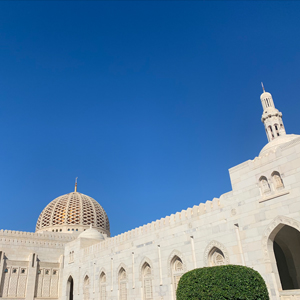
PRIYANKA SACHETI, like many other children of the Indian diaspora, looked forward to visiting India. But she was always glad to return to the Sultanate of Oman, which her parents had chosen over other Gulf states such as the U.A.E., Qatar, Bahrain, and Saudi Arabia. Although Oman could only be a temporary home for someone like her, it was still her home.
[Top] The Sultan Qaboos Grand Mosque in Muscat.
I was born into the Indian diaspora—specifically in Melbourne, Australia. I didn’t stay there for long, though, as we moved when I was a toddler to the land of my parents’ roots, Rajasthan. A few years later, I once more became part of the diaspora when my parents again left India believing that better opportunities awaited them as academics in the Sultanate of Oman. Little did they realize at the time that they would be calling it home for the next thirty years and that this decision would be fundamentally shaping their lives along with my younger brother’s and mine.
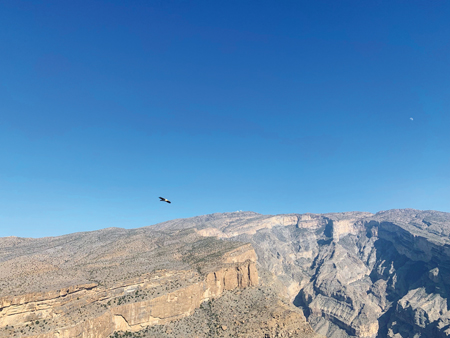
The first time my parents ever heard of Oman was when Oman’s then ruler, His Majesty Sultan Qaboos bin Said, invited India’s then Prime Minister Rajiv Gandhi to Oman’s 15th National Day celebrations in 1985. They recall watching the gloriously bedecked Omani capital, Muscat, on Doordarshan, little knowing that they would be celebrating the occasion in-person two years later.
[Right] Jabal Shams, often called the Grand Canyon of Arabia.
However, I cannot recall a time when I was not aware of Oman. In fact, I would be offended when I traveled from Oman to India for my summer holidays and encountered those ignorant of it. I grew tired of having to explain to people—whose sole association with the Middle East was either glitzy Dubai or extremely orthodox Saudi Arabia—that Oman and Dubai are two different places. In Oman, women did not have to wear an abaya and they could drive and hold jobs. “All my driving instructors are women, there are women ministers, the Sultan encourages the participation of women in the workforce,” I would rattle off to disinterested ears. It was a relief to return to Oman, where my real life awaited me and where I didn’t have to continually explain myself to anyone.
The majority of Oman’s expatriate population is Indian. According to a 2020 report, this community of about 700,000, including more than 567,000 workers, continues to be one of the largest expatriate communities in Oman. While there are several Indian-curriculum-based schools all across the Sultanate, it was a quirk of fate that led my parents to enroll me in a newly opened international school. This decision meant that I grew up with classmates from more than 50 different countries; and even now, my accent varies from American to British to Indian. I alternately use American and British spellings for words and prefer the American pronunciation of ‘z’. However, this linguistic ambiguity, funnily enough, did not translate into identity confusion on my part—that was to happen much later in my life. Despite attending an international school, I was very conscious and proud of my Indian identity and felt particularly patriotic on August 15.
Yet, I was aware that Indian accents and culture were often the butt of jokes and derision. I also knew that the Indians many of my non-South Asian classmates usually saw and associated with were migrant laborers. I still recall one awkward afternoon on the school bus as I listened to one of the cool kids, a Swedish boy, crack a joke about a plane threatening to crash. The plane’s occupants, three men of different nationalities, had to fling away something most abundant in their country to unburden the plane. “And when it came to the Gulf Arab, he threw an Indian away because there are so many of them,” the boy said, sniggering, until his eyes rested on me. “Sorry,” he added after a pause. “I didn’t mean you.” Up until then, I had been a lowly sixth grader whose presence he had barely registered, and yet, by the virtue of my skin color and nationality, I had come into focus and all he could think was to reassure me that I was not one of “them”: the anonymous mass of laborers with whom I could not possibly have had anything in common.
But we did. A passport.
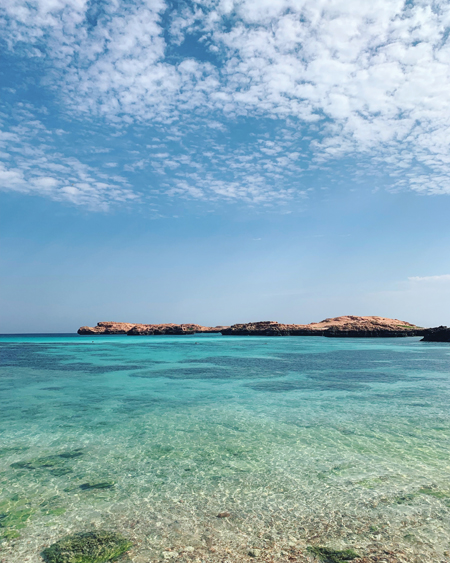
The 2022 Qatar World Cup highlighted, more than ever, the repressive living and working conditions which migrant laborers face in the Gulf states. Even through the self-absorption that childhood afforded me, I was still privy to how these laborers worked in excruciatingly hot summer months when the expatriates who could afford it all went home and escaped the relentless heat. I grew up hearing about the sponsorship system and how the “sponsors” withheld passports, offered meager wages, and more.
[Left] Damaniyat Islands, a protected marine reserve consisting of nine islands.
I recognized the dichotomy even before I acknowledged it: the privileged, insulated existence that I led in Oman and those who did not. Despite my limited interaction with the majority of the Indian population in Oman, the dichotomy weighed heavily on me—after all, there is only so much you can ignore and refuse to acknowledge when it lies right under your nose. For all the years when I extolled Oman, for all the times that I continue to do so, I now do it with the knowledge of the hard realities of the laborers who contributed towards making the country what it is now.
My interaction with other Indians like us was limited to the Indian families who worked and lived on the university campus. We also regularly met up with those families who belonged to Rajasthan but lived elsewhere in Muscat. Apart from the physical presence of Indians, I caught fragmentary glimpses of India: hearing bits of Hindi, Malayalam, and other Indian languages in the air, the Udupi restaurants where I discovered dosa and uttapam, the Indian grocery stores in downtown Muscat, and the two temples, of course, especially the two-century-old Shiva temple in the old Muscat, at the port of Muttrah.
Right up until my last Oman visit three years ago, I recall seeing the smiling Omani family who sold milk, oil, and other offerings to us and the other devotees from their stall outside the temple. They were probably more aware of the various Indian festivals and auspicious dates than I was! Many Indian families lived in Muttrah, home to a market that had historical resonance for several leading Indian-Omani families, whose existence speaks of centuries-long Indian presence and relationship with Oman. The Kutchi-speaking Hindu merchants first arrived in Muscat in 1507.
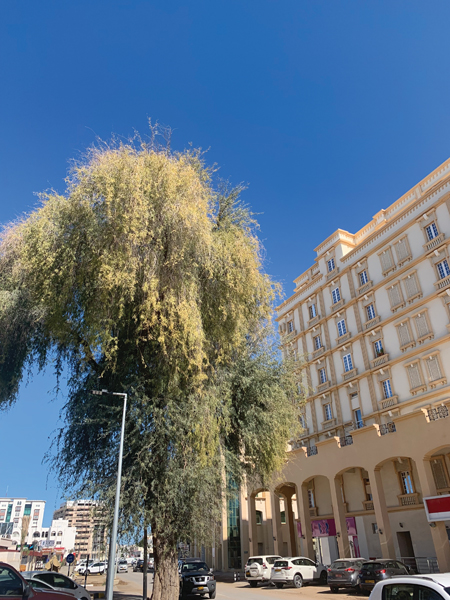 And yet, glimpses can substitute only so much for the actual experience as anyone pining for home can tell you. In my case, Hindi films and TV shows were my window into what I believed was my homeland. Given that my parents had ensured that we grew up speaking and understanding Hindi, I recall watching almost every Hindi film that was released in the late ’80s and the ’90s. Every Wednesday, which then marked the start of the Gulf weekend, my father would drive down to a video library in the nearby town of Seeb and bring the latest releases. We also watched taped episodes of Mahabharat and other TV serials before accessing Zee TV and other Indian satellite channels from the mid-’90s.
And yet, glimpses can substitute only so much for the actual experience as anyone pining for home can tell you. In my case, Hindi films and TV shows were my window into what I believed was my homeland. Given that my parents had ensured that we grew up speaking and understanding Hindi, I recall watching almost every Hindi film that was released in the late ’80s and the ’90s. Every Wednesday, which then marked the start of the Gulf weekend, my father would drive down to a video library in the nearby town of Seeb and bring the latest releases. We also watched taped episodes of Mahabharat and other TV serials before accessing Zee TV and other Indian satellite channels from the mid-’90s.
[Right] Al Khuwair, a neighborhood in Muscat.
Having seen them countless times in so many songs and scenes, I remember the excitement of visiting the Mumbai beaches and landmarks during our Indian trips. I dreamed of visiting and encountering movie stars on sets. Many Hindi filmmakers in that era aspired to dazzle their Indian audiences with glimpses of scintillating foreign locales. Later, after the success of Aditya Chopra’s Dilwale Dulhaniya Le Jayenge, Karan Johar and others followed in Chopra’s footsteps and began to focus on the NRI audiences in the belief that they desperately yearned to see their homeland. But perhaps the truth was that neither the audience nor the creators actually knew what homeland really was for these NRIs.
I was among that audience. It was when I began pursuing my undergraduate studies in the U.K. that I found myself questioning my identity more than ever and began to dwell on the idea of home and what it represented for me, a preoccupation that has lasted to date. I still thought of myself as an Indian, specifically an NRI, but it took me a mere month of my homesick student existence to recognize which home I was truly homesick for: Oman. After I finished university, I returned to Oman for a few years and worked as a freelance writer. Once there, I interacted with more Indians and Omanis than ever—an experience that fundamentally consolidated my identity confusion. Indians largely dominate and run the local journalism scene. I gravitated toward the Omanis in my quest to understand more about the country and its people. Looking back, it strikes me now: the two distinct halves of my Oman life—the childhood years and those of early adulthood—that made me aware of how much I considered Oman home, and yet, I could never fully call it mine.
If my student years in the U.K. revealed one truth, my subsequent years in Oman revealed another one: I never had much to do with Omanis. I lived in Oman, and I could rattle off statistics about its population or geography or history, but I neither spoke Arabic nor had Omani friends as a child. As per the government regulations, Omani students were not permitted to study in my school; and I personally did not interact with them elsewhere. And so, they became, simultaneously, a shadowy as well as a solid presence in my life—seen from a distance but never to be interacted with in proximity.
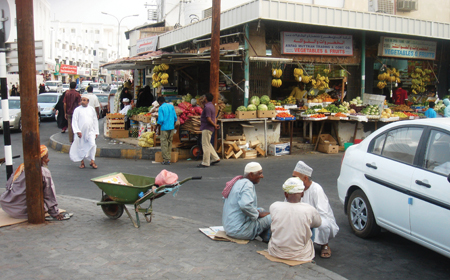
[Left] The traditional markets of Muttrah in Old Muscat.
After I started working as a freelance writer, I found myself meeting and conversing with more Omanis than ever, especially while focusing on writing about Omani women and their journeys. Exhausted by stereotypes about Arab women, I was intent on demolishing them in my own small way, writing about Omani women’s presence in various spheres. And yet, the more I wrote, the more I realized how much I had to learn and understand the intricacies that shaped this specific culture and community; and it seemed that despite all the years I had had of living in Oman, they had simply not been enough.
That brings me to the core of my Gulf diaspora experience: what distinguishes us from our brethren in, say, the United States or Australia—those who have acquired these countries’ citizenship and permanently reside there. Some time ago, I came across Deepak Unnikrishnan’s short story collection, A Temporary People. Like myself, Unnikrishnan was raised in the Gulf (Abu Dhabi, in his case). Having lived the Indian expatriate experience in the Gulf, Unnikrishnan could not have chosen a more apt title—because, ultimately, our presence in the Gulf could only be temporary. We never assumed that we could claim citizenship or permanently live there; we just knew we would have to move on elsewhere.
Even when I began my new chapter in Oman as a young adult, I never considered settling down there knowing that I could never be Omani. By then I had also realized that I could never call India home. No matter how important a role it played in my roots and identity, I would never be Indian enough.
So, what place would I be enough for? That existential question is for another day.
Even though my parents have now moved to Dubai, and it has been years since I last visited Oman, the ultimate truth is that Oman will forever remain my home. My childhood house turned out to be a temporary one too. And yet, I dream of it almost every night, knowing it is waiting there for me, just as are the mountains and beaches and roads and buildings in Oman—all that has made me the person I am today. This is the gift that my unique experience of being part of the Indian diaspora in the Gulf gave me and keeps on giving.
Priyanka Sacheti, based in Bengaluru, grew up in Oman and has lived in the U.K. and U.S. She has written about the environment, gender, and the arts for international digital and print publications. Her literary work has appeared in Barren, Khora, The Common, Khabar, Popshot, Lunch Ticket, Jaggery Lit, among other publications, and in anthologies. She can be found at @atlasofallthatisee (Instagram) and @priyankasacheti (Twitter)
Enjoyed reading Khabar magazine? Subscribe to Khabar and get a full digital copy of this Indian-American community magazine.
blog comments powered by Disqus










